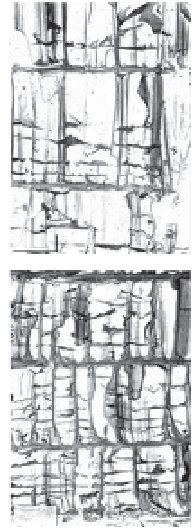Geoscience Reference
In-Depth Information
(B)
(A)
1.6
30
CO
2
animals
pH
NBS
7.10 W0.27
control animals
pH
NBS
8.01 W1.78
1.4
25
1.2
20
1.0
c
100 μm
b
15
0.8
(C)
0.6
10
0.4
5
0.2
a
a
100 μm
0
0.0
0
10
20
30
40
Incubation time (d)
Figure 8.5
(A) Growth (left y-axis) and CaCO
3
gain (bars, right y-axis) in the cuttlei sh, Sepia offi cinalis, during exposure to control (black, 400 μatm) and
elevated p CO
2
(6000 μatm; grey) (after Gutowska et al. 2008). Means for cuttlebone CaCO
3
not sharing the same letter are signii cantly different (n = 20 in
each group). Scanning electron micrographs show cuttlebone sections calcii ed in cuttlei sh kept under control conditions (B) and under a p CO
2
of 6000 μatm
(C). Increased CaCO
3
accretion during exposure to elevated seawater p CO
2
is also evident in the microstructure of the cuttlebones (data are means ± SD).
be concluded that standard ion regulatory capaci-
ties in the cuttlei sh are sufi cient to support acid-
base regulation during exposure to a
p
CO
2
of 3000
μatm, and that the cost of regulation does not sig-
nii cantly affect energy allocation to somatic growth,
at least in the centre of the thermal window. It needs
to be emphasized that cuttlei sh have lower meta-
bolic rates than the active squids discussed above,
and may thus not be as sensitive to high CO
2
.
During exposure to ocean acidii cation, changes
in the acid-base parameters of extracellular com-
partments have the potential to inl uence not only
metabolism but also calcii cation. Organisms that
are unable to compensate for chronic acidosis in
their extracellular space could experience reduced
calcii cation rates due to decreased CaCO
3
satura-
tion conditions at the site of calcii cation. In con-
trast, CaCO
3
saturation will increase at elevated
p
CO
2
in taxa that exhibit a strong regulatory
response. With rising
p
CO
2
in body l uids, extracel-
lular HCO
3
-
and CO
3
2-
will signii cantly accumulate
once control extracellular pH values have been
successfully stabilized. Interestingly, increased cal-
cii cation has been measured in both teleosts and
cephalopods during exposure to elevated seawater
p
CO
2
. Otolith mass (calculated from changes in sur-
face area) was found to increase by approximately
12% and 25% in 7-day-old
Atractoscion nobilis
reared
under
p
CO
2
values of 1000 and 2500 μatm, respec-
tively (Checkley
et al.
2009 ). Similar hypercalcii ca-
tion of an aragonitic structure has also been found
in
S. ofi cinalis
. Cuttlebones of juvenile cuttlei sh
maintained for 6 weeks at 6000 μatm accreted
22-55% more CaCO
3
(depending on i nal body
mass) than those maintained under control condi-
tions. At elevated
p
CO
2
the cuttlebone lamellar
spacing decreased from 384 ± 26 μm to 195 ± 38 μm
and pillar thickness increased from 2.6 ± 0.6 μm to
4.9 ± 2.2 μm (means ± SD; Gutowska
et al.
2010b ;
Fig. 8.5). Further studies are required to examine
the inl uence of hypercalcii cation at elevated
p
CO
2
levels on the functional control of otoliths for orien-
tation, and on the function of the cuttlebone as a
buoyancy regulation device.














































































